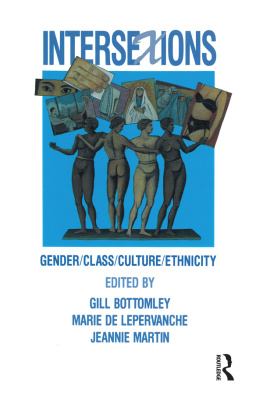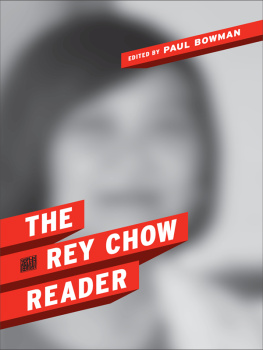Intersexions
First published 2020 by Allen & Unwin
Published 2020 by Routledge
2 Park Square, Milton Park, Abingdon, Oxon OX14 4RN
605 Third Avenue, New York, NY 10017
Routledge is an imprint of the Taylor & Francis Group, an informa business
Gill Bottomley, Marie de Lepervanche, Jeannie Martin, 1991
All rights reserved. No part of this book may be reprinted or reproduced or utilised in any form or by any electronic, mechanical, or other means, now known or hereafter invented, including photocopying and recording, or in any information storage or retrieval system, without permission in writing from the publishers.
Notice:
Product or corporate names may be trademarks or registered trademarks, and are used only for identification and explanation without intent to infringe.
National Library of Australia
Cataloguing-in-Publication entry:
Intersexions: gender, class, culture, ethnicity.
Bibliography
Includes index.
ISBN 0 04 442325 X.
1. Minority women-Social conditions. 2. Social classes. 3. Sex role.
I. Bottomley, Gillian, 1939 II. De Lepervanche, Marie M.
III. Martin, Jeannie A.
305.4
Set in 10.5/11.5pt Sabon by Graphicraft Typesetters Ltd., Hong Kong
ISBN-13: 9780044423256 (pbk)
Contents
Kalpana Ram
Santi Rozario
Kathy Robinson
Margaret Jolly
Jan Larbalestier
Gill Bottomley
Jeannie Martin
Marie de Lepervanche
Elite Vasta
Vanda Moraes-Gorecki
Jan Pettman
Guide
Gill Bottomley, Associate Professor in Anthropology and Comparative Sociology, Macquarie University
Marie de Lepervanche, Associate Professor in Anthropology, University of Sydney
Vanda Moraes Grecki, Lecturer in Anthropology, James Cook University, Queensland
Margaret Jolly, Senior Lecturer in Anthropology and Comparative Sociology, Macquarie University
Jan Larbalestier, Lecturer, School of Social Work and Social Administration, University of Sydney
Jeannie Martin, Senior Lecturer, Faculty of Humanities and Social Sciences, University of Technology, Sydney
Jan Pettman, Senior research fellow, Peace Research Centre, Research School of Pacific Studies, Australian National University, Canberra
Kalpana Ram, Tutor in Anthropology and Comparative Sociology, Macquarie University
Kathy Robinson, Senior lecturer in Anthropology and Comparative Sociology, Macquarie University
Santi Rozario, Lecturer in Sociology, Hunter Institute, University of Newcastle
Ellie Vasta, Lecturer, School of Sociology, University of Wollongong
In 1984, in Ethnicity Class and Gender in Australia, we attempted to move beyond unitary explanations of Australian immigration and its consequences. As that books name suggests, we included discussions of class, gender and ethnicity, rather than emphasising one perspective at the expense of the others. Although we failed to achieve this aim in all chapters, the books contributors have provided scholarly and thoughtful alternatives to the unidimensional analyses so dear to social scientists. The impact of Ethnicity Class and Gender has been difficult to assess, despite its relative success as a publication. Some writers have dismissed its triple perspective as a holy trinity or a litany, implying a form of religious incantation at some distance from our own critical and scholarly intentions. Others have continued to ignore one perspective or another as irrelevant, ideological or just too hard. But several major streams of scholarship have provided much stronger justification for approaches that challenge boundaries and stress interrelationships rather than divisions between ways of knowing.
The additional impetus that stimulated this second book came from those streams of thought. One of these developed in feminist debates concerned with the fragmentation of and perceived biases within the womens movement (see Carby 1982; Parmar 1982, 1989) and in debates about the decline of the grand narratives of social theory (see Pateman and Gross 1986; Fraser and Nicholson 1988). Just as we completed the manuscript of Ethnicity Classand Gender, two London-based sociologists published an important paper in Feminist Review contextualising feminism within and against the discourses of class and ethnicity (Anthias and Yuval-Davis 1983). This and similar papers have had a mixed reception from feminists, but they have also provoked substantial rethinking, a questioning of the notion of hierarchies of oppression, and a recognition that, in the words of the black American poet June Jordan, each one of us is more than what cannot be changed about us (quoted in Parmar 1989, p. 62). Moreover, accounts that fail to recognise this fact can themselves become forms of subjection, even if they are intended to be liberating.
Another, related, body of thought of importance to the themes of this book is that contained in recent anthropological and sociological post-colonial writing, which, like feminism, has profoundly challenged a number of dominant discourses. Issues of representation have become increasingly importantthe political representation of women and members of minority groups, and also their symbolic representation within particular discourses.
This latter concern has led to a healthy scepticism about the very bases of knowledge, and about the frames of reference that inform particular explanations. Broadly defined, this issue of representation is one of the main themes of our book. All of these chapters cover perceived racist, sexist, ethnocentric and class biases in sociological and anthropological writing and in other accounts of immigrant and colonised people, especially women. Although our approaches are critical, we are also concerned to offer alternatives, by combining comparative and specific analyses, by attention to material written or spoken by the people being represented, and by examining our own positions as commentators. Most importantly, we are all aware that categories and intellectual frameworks are constructed within relations of domination and subordination. Our aim in this book is not merely to offer a pluralist presentation of lifes rich tapestry, but to understand the processes by which such relations of power are maintained, reproduced and resisted.
Intersexions, therefore, moves a good deal further than Ethnicity Class and Gender in several ways. First, we have included material from beyond Australia that explores the central themes of the book. Four of the chapters draw on fieldwork undertaken by their authors in Vanuatu, Indonesia, India and Bangladesh. Part of our intention in widening our geographical scope was to introduce a more comparative perspective into feminist (and other) discussions about gender, class, ethnicity and culture. Most of the authors in this book have been trained as anthropologists and are well aware of the limitations and intractability of ethnocentrism. These chapters question accepted categories and offer insights into the processes of defining and contesting hegemonic relations of power based on caste, religion and colonialism, as well as class and gender. Thus, Kalpana Rams chapter dismantles the apparent unity and homogeneity in the term Hindu woman in her detailed study of the untouchable Mukkuvars of Kerala, whose assertive counter-caste identity emphasises masculine prerogatives and a specific cultural construction of gender. Santi Rozarios chapter raises questions about the notions of purity, honour and community in a Bangladeshi region where Christian women, while enjoying greater mobility than their Muslim counterparts, are still limited by the politics of both Christian and Muslim men, and by class relations. Kathy Robinson discusses the internal and international migration of Indonesian women, showing how cultural expectations and class relations are affected by regional origin, but also how quasi-familial ideas shape relations between employer and employee within, but not beyond, Indonesia. Margaret Jollys chapter examines the politics of colonialism and decolonisation in Vanuatu, including a historical view of colonialism and the intersection of racism and gender relations, whereby black women were subordinate to white women as well as to men, despite the fact that colonialism was a masculinist project. Some of the consequences of this history are revealed in the poetry and criticisms of a Vanuatuan woman poet and politician, Grace Mera Molisa, some of whose work is included in this chapter.




